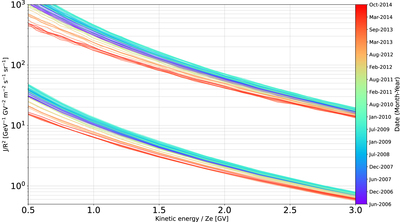Image Details

Caption: Figure 5.
Proton (top set of lines) and helium-nuclei (lower lines) fluxes (J) measured by the PAMELA experiment from 2006 June (violet) to 2014 September (red) divided by rigidity squared vs. kinetic energy divided by the charge (Ze). The displacements along the abscissa are similar between the two species and they are attributed to the varying with time of the solar modulation parameter.
Copyright and Terms & Conditions
© 2022. The Author(s). Published by the American Astronomical Society.







